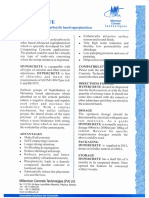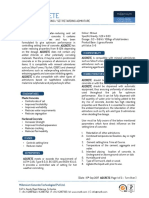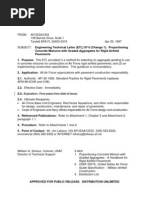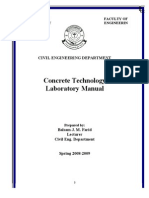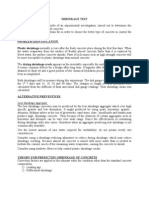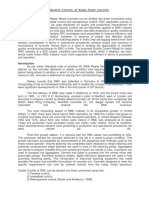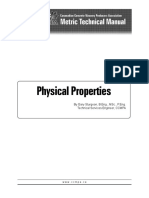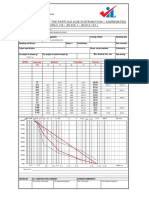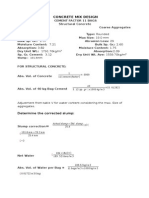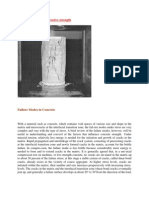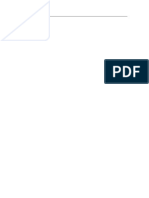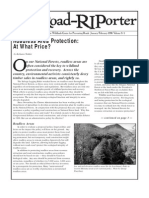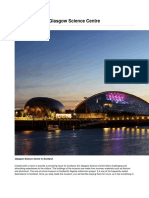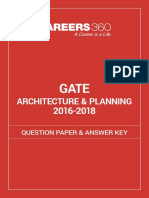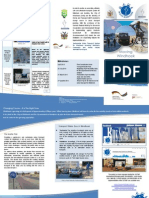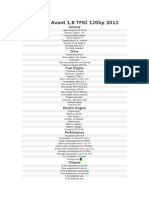Concrete Mix Design
Concrete Mix Design
Uploaded by
gauravrediffmailCopyright:
Available Formats
Concrete Mix Design
Concrete Mix Design
Uploaded by
gauravrediffmailOriginal Description:
Copyright
Available Formats
Share this document
Did you find this document useful?
Is this content inappropriate?
Copyright:
Available Formats
Concrete Mix Design
Concrete Mix Design
Uploaded by
gauravrediffmailCopyright:
Available Formats
SECTION 800
CONCRETE MIX DESIGN AND CONSTRUCTION
801.00 GENERAL CONDITIONS.............................................................. 3
810.00 SCOPE ............................................................................................ 3
811.00 Inspections ...........................................................................................3
820.00 CONCRETE MIX DESIGN ............................................................ 4
821.00 Materials ..............................................................................................4
821.01 Cement ............................................................................................4
821.02 Fly Ash............................................................................................5
821.03 Water...............................................................................................5
821.04 Admixtures......................................................................................5
821.05 Fine Aggregate ................................................................................6
821.06 Coarse Aggregate ............................................................................6
821.07 Fibrous Reinforcing .........................................................................6
822.00 Mix Properties......................................................................................6
822.01 Colored Patterned Concrete .............................................................7
822.02 Controlled Low Strength Materials (CLSM) ....................................7
823.00 Ready-Mixed Concrete.........................................................................8
824.00 Steel Reinforcing and Forms ................................................................9
824.01 Steel Reinforcing .............................................................................9
824.02 Forms and Form Setting ................................................................ 10
825.00 Concrete Testing ................................................................................11
826.00 Tests Provided by the Developer ........................................................ 12
830.00 CONCRETE CONSTRUCTION ................................................... 14
831.00 Placing Concrete ................................................................................14
831.01 Vibrating ....................................................................................... 14
831.02 Workability ...................................................................................15
831.03 Installation of Colored Patterned Concrete.....................................15
831.04 Weather Limitations ......................................................................16
832.00 Concrete Pavement and Flatwork ....................................................... 17
832.01 Portland Cement Treated Base....................................................... 18
832.02 Curb and Gutter .............................................................................18
832.03 Sidewalks ......................................................................................18
832.04 Crosspans and Curb Return Fillets .................................................18
832.05 Curb Cuts and Driveways .............................................................. 18
832.06 Curb Ramps...................................................................................18
832.07 Joints ............................................................................................. 19
832.08 Ponding ......................................................................................... 21
833.00 Appurtenant Concrete Structures ........................................................ 21
833.01 Forms ............................................................................................ 21
833.02 Concrete Placement .......................................................................21
833.03 Expansion Joints............................................................................21
833.04 Curing ........................................................................................... 21
CONCRETE MIX DESIGN AND CONSTRUCTION SECTION 800
834.00 Cleanup .............................................................................................. 21
835.00 Backfill of Concrete Work..................................................................22
836.00 Protection Against Vandalism ............................................................ 22
837.00 Repairs ............................................................................................... 22
837.01 Flatwork Repairs and Replacement ................................................22
837.02 Concrete Structure Repairs ............................................................ 23
838.00 Finishing, Curing and Protection ........................................................ 23
838.01 Finishing ....................................................................................... 23
838.02 Curing and Protection ....................................................................24
CONSTRUCTION STANDARDS & SPECIFICATIONS 2007 Edition PAGE 800-2
CONCRETE MIX DESIGN AND CONSTRUCTION SECTION 800
SECTION 800
CONCRETE MIX DESIGN AND CONSTRUCTION
801.00 GENERAL CONDITIONS
Refer to Section 100 TITLE, SCOPE AND GENERAL CONDITIONS of these
CONSTRUCTION STANDARDS & SPECIFICATIONS for additional requirements
that apply to all projects within Elbert County.
810.00 SCOPE
All Portland cement concrete work within any street, parking lot or R.O.W. or in any part
of the water system, sanitary sewer system, or storm drainage system of Elbert County
shall meet the requirements of these CONSTRUCTION STANDARDS &
SPECIFICATIONS.
811.00 Inspections
Refer to Section 154.00 Inspections and Section 931.00 Roadway Inspections of these
CONSTRUCTION STANDARDS & SPECIFICATIONS.
Adequate inspections assure compliance to Elbert County requirements and are the
basis for Elbert Countys recommendation that improvements be accepted for
maintenance and/or for release of performance guarantees. It is the responsibility of
the Contractor to contact the Road & Bridge Superintendent / Elbert County Engineer
a minimum of one (1) full working day (twenty-four [24] hours) in advance of the
required inspections. Required inspections shall include:
A. Subgrade Verify that material on which concrete shall be placed
is to the line, grade, and cross-section shown on the approved
plans, is not frozen or excessively dry at the surface, and meets all
compaction requirements.
B. Forms/Reinforcing Steel Verify that forms are set to proper grade
and alignment, adequately braced, and set for proper thickness of
concrete. Rebar is properly placed and spaced, at least fifty (50)
percent of intersections are tied, and proper distances from surface
grade and forms are maintained.
C. Concrete Delivery and Testing Confirm that mix design
submittals are approved by Elbert County, and testing/sampling
frequency, slump, air, and minimum/maximum air and concrete
temperatures comply with these CONSTRUCTION STANDARDS
& SPECIFICATIONS.
D. Cure and Flush Verify that Finished concrete complies with
approved grades and alignment and is properly cured. If required
by the Road & Bridge Superintendent / Elbert County Engineer,
verify that concrete pavement surfaces comply with the
CONSTRUCTION STANDARDS & SPECIFICATIONS 2007 Edition PAGE 800-3
CONCRETE MIX DESIGN AND CONSTRUCTION SECTION 800
smoothness requirements of Section 412.17 Surface Smoothness
Test of the CDOT Standard Specifications for Road and Bridge
Construction
E. General Items Include:
1. All temporary structures, debris, mud and waste materials
shall be removed from public property. Grout and seal all
cracks in concrete. Fill all gouged areas of concrete with
an approved epoxy. Remove and replace all areas of
broken concrete. Subgrade failures shall be corrected
before pouring back.
F. Construction Acceptance Refer to Section 200 ACCEPTANCE
PROCEDURES of these CONSTRUCTION STANDARDS &
SPECIFICATIONS.
G. Final Acceptance Refer to Section 200 ACCEPTANCE
PROCEDURES of these CONSTRUCTION STANDARDS &
SPECIFICATIONS.
820.00 CONCRETE MIX DESIGN
Concrete shall be composed of Portland cement, aggregate and water, and shall be
reinforced with steel bars or steel wire fabric where required.
Concrete mix design information shall be prepared in accordance with ACI 301 Section
4.2 and submitted to Elbert County for approval. At least two (2) sets of certified twenty-
eight (28) day strength test results shall also be submitted. No concrete shall be placed
until the concrete mix design has been approved by the Road & Bridge Superintendent /
Elbert County Engineer.
A separate mix design submittal shall be required for concrete to be pumped. Mix
designs shall be prepared in accordance with ACI 211 and 304, as applicable.
821.00 Materials
821.01 Cement
All cement used in concrete work shall be Portland cement that complies with
ASTM C150, Type I or Type II, except where Type V cement is required for
sulfate-resistant concrete. In general, Type II cement that complies with ASTM
C150 shall be used in concrete in contact with the soil, unless otherwise allowed
or directed by the Road & Bridge Superintendent / Elbert County Engineer.
Cement, which for any reason has become partially set or which contains lumps
shall be rejected.
The Contractor shall be responsible for proper storage of all cement until it is
used. When requested by the Road & Bridge Superintendent / Elbert County
Engineer, the Contractor shall furnish the Road & Bridge Superintendent / Elbert
CONSTRUCTION STANDARDS & SPECIFICATIONS 2007 Edition PAGE 800-4
CONCRETE MIX DESIGN AND CONSTRUCTION SECTION 800
County Engineer with a certificate from the manufacturer or an acceptable testing
laboratory stating that the cement meets the requirements of these
CONSTRUCTION STANDARDS & SPECIFICATIONS for Portland cement.
821.02 Fly Ash
Fly ash may be utilized in the concrete mix design when permitted by the Road &
Bridge Superintendent / Elbert County Engineer. Fly ash shall be Class C and
shall comply with ASTM C618. The pozzolanic index shall be eighty-five (85).
Fly ash may replace a maximum of twenty (20) percent of the amount of Portland
cement that otherwise is required to produce concrete of the specified
compressive strength. Class C fly ash shall not be permitted where sulfate
resistant cement is required.
The Contractor shall notify the Road & Bridge Superintendent / Elbert County
Engineer of the source of the fly ash prior to use in the project. When required by
the Road & Bridge Superintendent / Elbert County Engineer, the Contractor shall
provide the fly ash analysis performed by the fly ash supplier along with the
concrete mix proportions. The Road & Bridge Superintendent / Elbert County
Engineer may require a certificate from an approved testing laboratory stating that
the fly ash meets the requirements of these CONSTRUCTION STANDARDS &
SPECIFICATIONS.
821.03 Water
Water for concrete shall be clean and free from sand, oil, acid, alkali, organic
matter, or other deleterious substances and shall meet the requirements for mix
water as published in ASTM C94. Water from public supplies or water that has
been proven to be suitable for drinking is satisfactory.
821.04 Admixtures
The following requirements apply for admixtures:
A. The Contractor shall use air-entraining admixtures for all surfaces
of exposed concrete. Air entraining admixtures shall comply with
ASTM C260.
B. When weather restraints, site conditions or project requirements
require the ability to place concrete at a lower temperature,
produce accelerated concrete setting time or increase early and
ultimate compressive strengths, an accelerating admixture may be
utilized in the design mix when allowed by the Road & Bridge
Superintendent / Elbert County Engineer.
C. Calcium chloride may be utilized in the design mix when allowed
by the Road & Bridge Superintendent / Elbert County Engineer.
CONSTRUCTION STANDARDS & SPECIFICATIONS 2007 Edition PAGE 800-5
CONCRETE MIX DESIGN AND CONSTRUCTION SECTION 800
D. Type C accelerating admixtures and Type E water reducing and
accelerating admixtures shall meet ASTM C494.
E. When concrete is to be used with reinforcing steel, a non-chloride /
non-corrosive, admixture shall be used.
F. Dosage rates shall be determined by recommendation of the ready
mix company and shall be specified for daily site conditions.
821.05 Fine Aggregate
The fine aggregate shall be clean, hard, durable, uncoated particles of sand, free
from injurious amounts of clay, dust, soft or flaky particles, loam, shale, alkali,
organic matter, or other deleterious matter. Fine aggregate shall be well graded,
and when tested by means of laboratory sieves shall comply with ASTM C33.
The fine aggregate gradation shall comply with CDOT Fine Aggregate.
821.06 Coarse Aggregate
The coarse aggregate shall consist of broken stone or gravel that is clean, hard,
tough and durable, and free from soft, thin, elongated or laminated pieces,
disintegrated stone, clay, loam, vegetable, or other deleterious matter.
Coarse aggregate shall be well graded and when tested by means of laboratory
sieves shall comply with ASTM C33. The coarse aggregate gradation shall
comply with CDOT Coarse Aggregate Gradation # 467.
821.07 Fibrous Reinforcing
Fibrous concrete reinforcing shall not be used, unless approved by the Road &
Bridge Superintendent / Elbert County Engineer.
822.00 Mix Properties
Mix properties of Portland cement concrete for flatwork shall comply with the
following:
Property Mix Design
Minimum compressive strength - 28 days* 3000 psi
Minimum cement - sacks/cubic yard 6
Maximum water/cement ratio - by weight 0.50
Slump - inches 1-4
Air entrainment - % by volume 5-8
* When tested in accordance with ASTM C31
The grading and composition requirements for coarse and fine aggregate for concrete
shall be in accordance with the CDOT Standard Specifications for Road and Bridge
Construction. Additional concrete mix designs may be approved for decorative, non-
CONSTRUCTION STANDARDS & SPECIFICATIONS 2007 Edition PAGE 800-6
CONCRETE MIX DESIGN AND CONSTRUCTION SECTION 800
structural concrete at the discretion of the Road & Bridge Superintendent / Elbert
County Engineer.
822.01 Colored Patterned Concrete
COLOR SHALL BE AS NOTED ON THE APPROVED DRAWINGS OR AS
APPROVED BY THE ROAD & BRIDGE SUPERINTENDENT / ELBERT
COUNTY ENGINEER.
Where required on the approved plans, colored patterned concrete shall comply
with the following:
A. Minimum twenty-eight (28) day compressive strength of concrete
shall be 4,000 psi.
B. Air entrainment shall be six (6) percent [+ 1%] for maximum
aggregate size of three-quarter () inch or one (1) inch and shall
be seven and one-half (7 ) percent [+ 1%] for a maximum
aggregate size of three-eight () inch or one-half () inch.
C. Normal set or retarded set water reducing admixture shall comply
with ASTM C494.
D. No calcium chloride shall be added to the concrete mix.
E. Matching integral color shall be used as a supplement, but not as a
color hardener.
F. Color hardener shall be specially formulated for installation of
patterned concrete, grade Heavy Duty. Color curing compound
shall comply with ASTM C309 and with all applicable air
pollution regulations.
822.02 Controlled Low Strength Materials (CLSM)
CLSM (Flowable Fill) mix designs shall be submitted to the Road & Bridge
Superintendent / Elbert County Engineer for approval prior to placement. CLSM
used as structure backfill, as backfill for pipelines and service lines, or to fill
abandoned pipelines and appurtenances shall have a twenty-eight (28) day
compressive strength between fifty (50) and one-hundred fifty (150) psi, as tested
by ASTM D4832.
CLSM shall be placed in confined areas and under pipe haunches with methods
approved by Elbert County. When backfilling pipelines and service lines, CLSM
shall be properly layered to prevent pipe from floating.
Onsite material mix designs may be approved. Test sections may be required and
a placement plan may be required to be submitted for approval by the Road &
Bridge Superintendent / Elbert County Engineer.
CONSTRUCTION STANDARDS & SPECIFICATIONS 2007 Edition PAGE 800-7
CONCRETE MIX DESIGN AND CONSTRUCTION SECTION 800
The following CLSM mix properties and proportions apply:
CLSM Mix Requirements
Property Mix Design
Minimum 24-hour strength 15 psi
Maximum 28-day strength 50-150 psi
Maximum aggregate size 1 (100% Passing)
ASTM C150 Type I-II (or
Portland Cement
Type V for sulfate resistance)
Slump 4 8
Mix Proportions (per cubic yard of concrete)
Material lbs./yd3
Cement 501
Water3 325 (39 gallons) or as needed
Coarse Aggregate
1700
(AASHTO No. 57 or 67)
Fine Aggregate
1845
(AASHTO M6)3
1
40 lbs. /yd3 cement and 10 lbs. /yd3 Class C fly ash may be substituted for 50
lbs. /yd3 cement.
2
CLSM shall flow into place without excessive segregation or bleed water.
3
The percent passing the #200 sieve shall be between 8% - 20%.
823.00 Ready-Mixed Concrete
The use of ready-mixed concrete shall in no way relieve the Contractor or Developer
of the responsibility for proportion, mix, delivery, or placement of concrete. All
ready-mixed concrete shall comply with ASTM C94.
Concrete shall be continuously mixed or agitated from the time the water is added
until the time of use, and discharge from the truck should begin within ninety (90)
minutes or three-hundred (300) revolutions after it comes in contact with the mixing
water or with the aggregates. In accordance with ASTM C94, water may be added to
ready-mix concrete one time in order to get slump within range, as long as the
specified water-cement ration is not exceeded.
Elbert County shall have free access to the ready mix plant at all times. The
organization supplying the concrete shall have sufficient plant and transportation
facilities to assure continuous delivery of the concrete at the required rate.
CONSTRUCTION STANDARDS & SPECIFICATIONS 2007 Edition PAGE 800-8
CONCRETE MIX DESIGN AND CONSTRUCTION SECTION 800
The contractor shall collect delivery or batch tickets from the driver for all concrete
used on the project and shall deliver them to the Road & Bridge Superintendent /
Elbert County Engineer. Batch tickets shall provide the following information in
accordance with ASTM C94:
A. Name of ready-mix batch plant
B. Serial number of ticket
C. Date
D. Truck number
E. Name of purchaser
F. Specific designation of job (name and location)
G. Mix # or specific class or designation of the concrete
H. Amount of concrete in cubic yards
I. Time loaded or of first mixing of cement and aggregates
J. Water added by receiver of concrete and his initials
K. Weights of fine and coarse aggregates
L. Type, brand and amount of cement
M. Type, brand and amount of admixtures
N. Weight (in gallons) of water, including surface water on aggregates
824.00 Steel Reinforcing and Forms
824.01 Steel Reinforcing
The placement, fastening, splicing and supporting of reinforcing steel and wire
mesh or bar mat reinforcement shall comply with the plans and the latest edition
of CRSI Recommended Practice for Placing Reinforcing Bars. Before being
positioned, all reinforcing steel shall be thoroughly cleaned of mill and rust scale
and of coatings that may destroy or reduce the bond. Where there is delay in
depositing concrete, reinforcement shall be reinspected and cleaned if necessary.
Reinforcement shall be carefully formed to the dimensions indicated on the
approved plans by the cold bending method. Cold bends shall be made so that the
inside diameter of the bend measured on the inside of the bar shall be as follows:
Bar Size Grade 60
#3 through #8 6 bar dia.
#9, #10, and #11 8 bar dia.
#14 and #18 10 bar dia.
The inside diameter of bend for stirrups and ties shall not be less than four (4) bar
diameters for sizes #5 and smaller, and five (5) bar diameters for #6 and #8.
Reinforcement shall not be bent or straightened in a manner that may injure the
material. Bars with kinks or bends shall not be used except where shown on the
plans. Heating of reinforcement shall not be permitted.
CONSTRUCTION STANDARDS & SPECIFICATIONS 2007 Edition PAGE 800-9
CONCRETE MIX DESIGN AND CONSTRUCTION SECTION 800
Reinforcing steel shall be accurately placed and secured against displacement by
using annealed iron wire of not less than No. 18 gauge, or by suitable clips at
intersections. A minimum of fifty (50) percent of intersections shall be secured.
Where necessary, reinforcing steel shall be supported by metal chairs or spacers,
pre-cast mortar blocks, or metal hangers. Splicing of bars, except where shown
on the plans, shall not be allowed without approval of the Road & Bridge
Superintendent / Elbert County Engineer.
Welded wire fabric for concrete reinforcement shall be of the gauge, spacing,
dimensions, and form specified on the plans or Detailed Drawings and shall
comply with Specifications for Welded Steel Wire Fabric for Concrete
Reinforcement (ASTM A185) or Specifications for Welded Deformed Steel
Wire Fabric for Concrete Reinforcement (ASTM A497).
Contractor shall submit shop drawings of the reinforcement to the Road & Bridge
Superintendent / Elbert County Engineer for approval. Unless otherwise shown
on the plans, the minimum clear cover for reinforcing steel shall be the following,
as specified in Section 5.5 of ACI 301:
Bottom bars on soil bearing foundations & slabs 3 inches
Bars adjacent to surfaces exposed to weather or earth backfill 1 inches
Interior surfaces inches
824.02 Forms and Form Setting
Forms shall have sufficient strength to withstandwithout deformationthe
pressure resulting from placement and vibration of the concrete. Forms shall be
constructed so that the finished concrete shall conform to the shapes, lines, grades
and dimensions indicated on the approved plans. Any form which is not clean
and which has not had the surface prepared with commercial form oil to
effectively prevent bonding, staining, and softening of concrete surfaces shall not
be used.
Forms may generally be wood or metal and shall have a depth equal to or greater
than the slab thickness. Plywood forms, plastic coated plywood forms, or steel
forms shall be used for all surfaces requiring forming which are exposed to view,
whether inside or outside any structure. Surfaces against backfilled earth, interior
surfaces of covered channels, or other places permanently obscured from view,
may be formed with forms having sub-standard surfaces.
Forms that have become worn, bent, or broken shall not be used. Each section of
form shall be straight and free from warps. The Contractor shall set a minimum
length of three hundred (300) feet of forms to grade prior to placing concrete. In
CONSTRUCTION STANDARDS & SPECIFICATIONS 2007 Edition PAGE 800-10
CONCRETE MIX DESIGN AND CONSTRUCTION SECTION 800
cases where the length of one run is less than three hundred (300) feet, the
Contractor shall set forms to grade for the entire run.
The face of curbs shall be formed, unless otherwise permitted by the Road &
Bridge Superintendent / Elbert County Engineer. Forms shall be secured to resist
the pressure of the poured concrete without springing or settlement. The
connection between sections shall be performed by a method in which the joint
shall be free from movement in any direction.
Forms shall not deviate more than one-quarter () inch from the design line and
grade.
When concrete pavement is constructed on a curve, flexible forms shall be used
having a radius of two hundred (200) feet or less, unless otherwise directed by the
Road & Bridge Superintendent / Elbert County Engineer. Face forms shall be
preformed to the proper radius. Care shall be exercised to ensure the required
cross section is maintained around the entire radius.
The Contractor shall provide an approved metal straight edge, ten (10) feet in
length, to check the alignment of the forms prior to placing the concrete, and to
check the concrete surface during the finishing operation.
Forms shall not be disturbed until the concrete has hardened sufficiently to permit
removal without damaging the concrete, or until forms are not required to protect the
concrete from mechanical damage. The minimum duration of time before removal of
forms after placing concrete shall be one (1) day for footings and two (2) days for all
other concrete. Crowbars or other heavy tools shall not be used against green
concrete when removing forms. Forms shall be thoroughly cleaned before re-oiling
and reuse.
825.00 Concrete Testing
The requirements of this section shall apply to testing services for all concrete curb
and gutter, sidewalk, pavement, slope paving, retaining walls, structures, and for all
miscellaneous concrete testing.
The required concrete testing services shall be performed by a designated concrete
testing agency approved by the Road & Bridge Superintendent / Elbert County
Engineer, and that meets the requirements of ASTM E329.
A representative of the concrete testing agency shall inspect, sample, and test material
and production of concrete as required by the Road & Bridge Superintendent / Elbert
County Engineer. When it appears that any material furnished or work performed by
the Contractor fails to fulfill specification requirements, the testing agency shall
report such deficiency to the Road & Bridge Superintendent / Elbert County Engineer
and the Contractor.
CONSTRUCTION STANDARDS & SPECIFICATIONS 2007 Edition PAGE 800-11
CONCRETE MIX DESIGN AND CONSTRUCTION SECTION 800
The concrete testing agency shall report all test and inspection results to the Road &
Bridge Superintendent / Elbert County Engineer and Contractor immediately after
they are performed. All test reports shall include the exact location of the work at
which the batch represented by a test was deposited. The report of the strength test
shall include detailed information on storage and curing of specimen prior to testing,
the project number, and the location of the concrete (curb, manhole, inlet, sidewalk,
paving, etc.).
The concrete testing agency or its representative is not authorized to revoke, alter,
relax, expand or release any requirements of these CONSTRUCTION STANDARDS
& SPECIFICATIONS, nor to approve or accept any portion of the work.
826.00 Tests Provided by the Developer
The Developer shall provide the concrete testing agency with the following:
Any labor necessary to assist the designated concrete testing agency in obtaining and
handling samples at the project or from other sources of material.
Provide and maintain for the sole use of the concrete testing agency adequate
facilities for safe storage and proper curing of concrete test specimens on the project
site as required by AASHTO T23.
The use of concrete testing services shall not relieve the Contractor of the
responsibility to furnish material and construct in full compliance with these
CONSTRUCTION STANDARDS & SPECIFICATIONS.
In the case of questionable concrete materials or work, the Road & Bridge
Superintendent / Elbert County Engineer may direct that core tests be taken on all
questionable concrete placements, at the Contractors expense. If the concrete shows
inadequate strength or other deficiencies, it shall be removed and replaced at the
Contractors expense. If any core shows a deficiency of thickness greater than one-
half () inch, exploratory cores shall be taken in increments as dictated by the Road
& Bridge Superintendent / Elbert County Engineer, and all concrete deficient by more
than one-half () inch shall be removed and replaced at the Contractors expense.
The following services shall be performed by the designated concrete testing agency
at the expense of the Developer:
A. Conduct strength test of the concrete during construction in
accordance with the following procedure: Secure composite
samples in accordance with AASHTO T141. Mold and cure
specimens from each sample in accordance with AASHTO T23.
The maximum time between sampling and casting the cylinders or
beams shall be fifteen (15) minutes. If cylinders or beams cannot
be returned to the laboratory and cast within the forty-five (45)
minutes, they shall be cast in the field and transported to the
CONSTRUCTION STANDARDS & SPECIFICATIONS 2007 Edition PAGE 800-12
CONCRETE MIX DESIGN AND CONSTRUCTION SECTION 800
laboratory in twelve (12) to twenty-four (24) hours. One (1) field
cured test series and one (1) lab cured test series shall be taken in
the first fifty (50) cubic yards (or fraction thereof) of the concrete
placed per day, and one (1) field cured test series and one (1) lab
cured test series shall be taken fifty (50) cubic yards after that.
One (1) field cured test series and one (1) lab cured test series shall
continue to be taken every one-hundred (100) cubic yards until the
end of the work day. Special projects may require more frequent
testing, as directed by the Road & Bridge Superintendent / Elbert
County Engineer.
1. Field cured test series (if required by the Road & Bridge
Superintendent / Elbert County Engineer):
Four (4) cylinders; two (2) to be broken at seven (7) days; two (2) to be broken at
fourteen (l4) days or as directed by the Road & Bridge Superintendent / Elbert
County Engineer.
2. Lab cured test series:
Six (6) cylinders; Two (2) to be broken at seven (7) days; two (2) to be broken at
twenty-eight (28) days*; two (2) to be broken at forty-five days. *If the specified
strength is not obtained at twenty-eight (28) days, two (2) cylinders shall be
broken at forty-five (45) days.
B. Determine slump of the concrete sample of each strength test
whenever consistency of concrete appears to vary, or when
directed by the Road & Bridge Superintendent / Elbert County
Engineer, in accordance with AASHTO T119.
C. Determine air content of the concrete sample for each strength test
in accordance with either AASHTO T152 (pressure method), T196
(volumetric method), or T121 (gravimetric method).
D. Sample additional concrete at point of placement, and perform
other testing or inspection services as required.
E. The Developer or Contractor shall provide two (2) copies of all
concrete strength test results to the Road & Bridge Superintendent
/ Elbert County Engineer.
F. The Developer or Contractor shall provide additional testing and
inspection required due to changes in materials or proportions or
irregularities in specified procedures.
G. When the work fails to pass inspection or previous tests fail to
meet specifications, additional tests shall be taken as directed by
the Road & Bridge Superintendent / Elbert County Engineer.
H. Core samples shall be obtained and tested when samples of fresh
concrete were not obtained and tested in accordance with the
provisions of these CONSTRUCTION STANDARDS &
SPECIFICATIONS. Obtaining and testing cores shall comply
with ASTM C42. Concrete in the area represented by a core test
shall be considered adequate if the average strength of the cores is
CONSTRUCTION STANDARDS & SPECIFICATIONS 2007 Edition PAGE 800-13
CONCRETE MIX DESIGN AND CONSTRUCTION SECTION 800
equal to at least eighty-five (85) percent of the specified strength
(f'c), and if no single core is less than seventy-five (75) percent of
the specified strength. Core holes shall be filled with low slump
concrete or mortar. Cores may be tested in the dry condition in
accordance with ACI 301.
I. Failure of the Contractor to furnish testing as herein described shall
be sufficient cause for rejection of the work in question.
830.00 CONCRETE CONSTRUCTION
831.00 Placing Concrete
Before placing concrete, debris shall be removed from the space to be occupied by
the concrete. The forms and all concrete surfaces shall be thoroughly wetted. The
concrete shall be placed on damp but not wet or muddy subgrade. Concrete shall be
placed and compacted so that it is free from honeycomb and free from pockets of
segregated aggregate. Sections of segregation or honeycomb revealed by removal of
the forms shall be removed and replaced or otherwise repaired as approved by the
Road & Bridge Superintendent / Elbert County Engineer.
Concrete shall not be placed until all forms and reinforcing steel have been inspected
and approved by the Elbert County Inspector/Representative. Concrete shall be
handled from the mixer to the place of final deposit as rapidly as possible by methods
that prevent separation or loss of ingredients. The concrete shall be deposited in the
forms as close as practicable in its final position to avoid re-handling. It shall be
deposited in continuous layers, the thickness of which generally shall not exceed
twelve (12) inches. Concrete shall be placed in a manner to avoid segregation and
shall not be dropped freely more than five (5) feet. If segregation occurs, the Elbert
County Inspector/Representative may require the concrete to be removed and
replaced at the Contractor's expense.
Concrete shall be placed in one continuous operation, except where keyed
construction joints are shown on the plans or as approved by the Road & Bridge
Superintendent / Elbert County Engineer. Delays in excess of thirty (30) minutes
may require removal and replacement of concrete by the Road & Bridge
Superintendent / Elbert County Engineer. At the end of the work day, or in case of an
unavoidable interruption of more than thirty (30) minutes, a transverse construction
joint shall be placed at the point of stopping work, provided that the section on which
work has been suspended shall not be less than five (5) feet long. Sections less than
five (5) feet in length shall be removed. Concrete shall not be placed when the
weather is stormy, dusty, or inclement to a degree that precludes good workmanship.
831.01 Vibrating
All concrete shall be compacted by internal vibration using mechanical vibrating
equipment. Concrete in floor slabs, sidewalks, or curb and gutter which is not
CONSTRUCTION STANDARDS & SPECIFICATIONS 2007 Edition PAGE 800-14
CONCRETE MIX DESIGN AND CONSTRUCTION SECTION 800
placed against form linings shall be either tamped or vibrated. Care shall be taken
to vibrate only long enough to bring a continuous film of mortar to the surface.
Vibration shall stop before any segregation of the concrete occurs. Mechanical
vibrators shall be an approved type as specified in ACI 309, Chapter 5. Vibrators
shall not be used to move or spread the concrete.
Any evidence of lack of consolidation or over-consolidation shall be regarded as
sufficient reason to require removal and replacement of concrete at the
Contractor's expense. The Contractor shall be responsible for any defects in the
quality and appearance of the concrete.
831.02 Workability
The consistency of concrete shall be kept uniform and shall be checked by means
of certified slump tests. The workability of the concrete shall be varied as
directed by the Road & Bridge Superintendent / Elbert County Engineer. At all
times concrete shall have a consistency such that it can be worked into corners
and angles of the forms and around joints, dowels and tie-bars by the construction
methods which are being used without excessive spading, segregation or undue
accumulation of water or laitance on the surface. If, concrete fails to conform to
the proportions of the approved mix design for any reason, such concrete shall not
be incorporated in the work but shall be discarded from the project site as waste
material at the Contractor's expense. NO WATER MAY BE ADDED AT THE
JOB SITE WITHOUT PERMISSION OF THE ROAD & BRIDGE
SUPERINTENDENT / ELBERT COUNTY ENGINEER. If approval is
obtained and water is added at the job site, slump tests shall be performed and test
cylinders cast at the Contractors expense.
831.03 Installation of Colored Patterned Concrete
Special concrete mix with integral color shall be placed and screeded to the
proper grade, and floated to a uniform surface in the normal manner for slabs on
grade. Color hardener shall be applied evenly to the plastic surface by the dry
shake method using a minimum of sixty (60) pounds per one hundred (100)
square feet. Color hardener shall be applied in two (2) or more shakes, floated
after each, and troweled only after the final floating.
While the concrete is still plastic, the imprinting tools shall be applied to make the
desired patterned surface. The pattern shall be matched at imprint edges and
joints.
Color curing compound, thinned in the proportion of one (1) part curing
compound to one (1) part mineral spirits (paint thinner), shall be applied
uniformly with a roller or sprayer. The coverage shall be approximately six
hundred (600) to six hundred fifty (650) square feet per gallon of unthinned
curing compound. At times when the air temperature is at or near freezing, the
CONSTRUCTION STANDARDS & SPECIFICATIONS 2007 Edition PAGE 800-15
CONCRETE MIX DESIGN AND CONSTRUCTION SECTION 800
slab shall be cured using suitable curing blankets. The slab shall later be sealed
with the color curing compound when the air temperature is above freezing.
Use of blankets and/or heaters may be necessary to maintain the concrete at or
above fifty (50) degrees F for three (3) days after placement. The cured surface
shall be cleaned to remove any residual materials.
831.04 Weather Limitations
831.04.01 Cold Weather Concreting
During extreme weather conditions, placement of concrete shall be
allowed only when the temperature of the concrete placed in the forms is
between 60 degrees F and 90 degrees F. Cold weather placement of
concrete shall comply with ACI 306.
Concrete may be placed when the air temperature in the shade is 40
degrees F AND RISING. No concrete shall be placed, regardless of the
present temperature, when the weather forecast predicts freezing weather
before final set of the concrete unless special means of heating and
protection are used. Protection against freezing is the Contractor's
responsibility regardless of the weather forecast or climatic conditions at
the time of placement.
Small structures and slabs shall be protected by completely covering fresh
concrete with suitable curing blankets to prevent freezing. Large
structures and vertical walls shall be protected against freezing by
enclosing the structure with heating devices capable of providing uniform
and even heat throughout the structure. Heaters shall be vented so that
combustion gases are exhausted outside the enclosure in order to avoid
carbonation of the fresh concrete.
Cold weather is defined as a period when, for more than three (3)
consecutive days, the following conditions exist:
A. The average air temperature is less than 40 degrees F.
B. The air temperature is not greater than 50 degrees F for more than
one half of any 24-hr. period.
Concrete placed in cold weather shall be protected from extreme
temperatures as follows:
A. A temperature of at least 50 degrees F for the first seventy-two
(72) hours shall be maintained.
B. After the first seventy-two (72) hours and until the concrete is
seven (7) days old, it shall be protected from freezing
temperatures.
C. Concrete adjacent to heating devices shall be insulated from direct
heat of the unit that may dry it out prior to being properly cured.
CONSTRUCTION STANDARDS & SPECIFICATIONS 2007 Edition PAGE 800-16
CONCRETE MIX DESIGN AND CONSTRUCTION SECTION 800
D. Temperatures shall be measured by maximum and minimum
thermometers furnished by the Contractor and installed adjacent to
the concrete.
Concrete slabs shall not be placed, regardless of temperature conditions, if
the supporting ground is frozen or contains frost. Use of salt or other
additives to prevent concrete from freezing is not allowed. Concrete
which has been frozen shall be removed and replaced as required by the
Road & Bridge Superintendent / Elbert County Engineer.
MINIMUM EXPOSURE TEMPERATURE FOR CONCRETE FLATWORK
(FOR PORTLAND CEMENT CONCRETE = 500 lb./CY)
Minimum Ambient Air Temperature Allowable
Slab Thickness
For Values of Thermal Resistance (R),
(inches)
hr*ft*F/BTU
R=2 R=4 R=6
4 ** ** **
8 ** ** **
12 42F 36F 30F
18 30F 12F -6F
24 21F -5F -31F
** > 50F. Additional heat required.
831.04.02 Hot Weather Concreting
Except by written authorization, concrete shall not be placed if the
temperature of the plastic concrete cannot be maintained at 90 degrees F
or lower. Placement of concrete in hot weather shall comply with ACI
305.
832.00 Concrete Pavement and Flatwork
The installation of Portland cement concrete pavement, including materials,
equipment, foundation and construction methods shall comply with Section 412 of the
CDOT Standard Specifications for Road and Bridge Construction and these
CONSTRUCTION STANDARDS & SPECIFICATIONS.
Concrete pavements shall be installed as shown on the approved plans or as approved
by the Road & Bridge Superintendent / Elbert County Engineer. The Contractor shall
furnish steel pins to use in setting grades for concrete pavement.
The subgrade shall conform to the specified cross section. Immediately prior to
placing concrete, the subgrade shall be tested for adequate compaction and moisture to
a minimum depth of six (6) inches or as specified in the approved Geotechnical
Report. Concrete shall not be placed on any portion of the subgrade that has not been
CONSTRUCTION STANDARDS & SPECIFICATIONS 2007 Edition PAGE 800-17
CONCRETE MIX DESIGN AND CONSTRUCTION SECTION 800
inspected by a Elbert County Inspector/Representative. There shall be no puddles or
pockets of mud when the concrete is placed, and the subgrade shall be cleared of any
loose material.
Curb, curb ramps, gutter, sidewalk, cross pan, and driveway construction shall
conform to all applicable provisions of these CONSTRUCTION STANDARDS &
SPECIFICATIONS.
832.01 Portland Cement Treated Base
In those instances where deemed necessary by the project Soils Engineer and
approved by the Road & Bridge Superintendent / Elbert County Engineer,
Portland cement treated base may be required.
832.02 Curb and Gutter
The section to be constructed shall be as identified on the approved plans and as
shown on the Detail Drawings of these CONSTRUCTION STANDARDS &
SPECIFICATIONS.
832.03 Sidewalks
Detached sidewalks shall be a minimum of four (4) inches thick and attached
sidewalks shall be a minimum of six (6) inches thick, and shall be constructed as
shown on the approved plans. Areas of sidewalk crossed by driveways or in
parks, open spaces or greenbelts shall be constructed with a minimum of six (6)
inch thick concrete.
832.04 Crosspans and Curb Return Fillets
Crosspans and curb return fillets shall be constructed twelve (12) inches thick or
eight (8) inches thick one-half () inch (#4) reinforcing steel bars placed at
eighteen (18) inch centers (each way) in residential, commercial and industrial
areas. Typical crosspan sections are shown in the Detail Drawings. Where
unusual conditions exist, additional reinforcing steel and special joints may be
required by the Road & Bridge Superintendent / Elbert County Engineer.
832.05 Curb Cuts and Driveways
Curb cuts in six (6) inch vertical curbs shall be constructed at all driveway
locations and at additional locations, as shown on the approved plans and in the
Detail Drawings.
832.06 Curb Ramps
CONSTRUCTION STANDARDS & SPECIFICATIONS 2007 Edition PAGE 800-18
CONCRETE MIX DESIGN AND CONSTRUCTION SECTION 800
Curb ramps shall be installed at locations designated by the County Engineer and
as shown on the approved plans. Curb ramps shall be constructed with slopes,
landings, and detectable warnings (truncated domes) as shown in the Detail
Drawings. Specific installation details shall be per the manufacturer.
The following materials may be used for truncated domes:
A. Fiber reinforced polymer tiles
B. Cast iron tiles
C. Preformed cementitious tiles
D. Thermoplastic tiles
The actual truncated dome material to be installed for a specific project or
location shall be designated by the Road & Bridge Superintendent / Elbert County
Engineer.
832.07 Joints
Joint materials shall comply with the following specifications:
Concrete joint sealer, hot-poured elastic M173
Preformed expansion joint filler (Bituminous Type) M33
Preformed sponge rubber and cork expansion joint fillers M153
Preformed expansion joint fillers (fiber board) M213
Non-bituminous type materials shall be placed in widths shown on the approved
plans or three-eighths () inch wide when not specified. Bituminous type
materials shall be used for concrete paving and structural construction where joint
sealers are not required.
All joints shall be constructed straight and plumb and shall extend through the
entire section from edge to back and to the depths specified.
832.07.01 Expansion Joints
Expansion joint material shall be provided at the following locations and
shall be in place prior to placement of concrete:
A. Each end of curb return
B. Between back of sidewalk and driveway slab or service walk
C. Between new concrete and existing masonry buildings
D. As shown on the approved plans
E. As directed by the Road & Bridge Superintendent / Elbert County
Engineer
CONSTRUCTION STANDARDS & SPECIFICATIONS 2007 Edition PAGE 800-19
CONCRETE MIX DESIGN AND CONSTRUCTION SECTION 800
Reinforcing steel bars (#4, 18 long minimum) shall be used to tie
together new and existing concrete pavements and flatwork. Refer to the
Detail Drawings for expansion joints.
Expansion joint filler, which is one-half () inch thick, preformed, non-
extruding bituminous-treated fiber board conforming to AASHTO
Specification M-213, shall be used to form transverse expansion joints.
Concrete tie-ins shall have reinforcing steel bars (#4 minimum) extending
a minimum of twelve (12) inches into the concrete in each direction.
Expansion joints shall be constructed at each tangent point of the curb
radius, at each end of valley gutters, at approximately one hundred fifty
(150) foot intervals on tangent, or at other points as directed by the Road
& Bridge Superintendent / Elbert County Engineer. Expansion joints shall
be formed at the contact of the new construction with concrete driveways,
intersecting sidewalks, or other unyielding structures unless otherwise
directed by the Elbert County Inspector/Representative.
832.07.02 Contraction Joints
Transverse joints shall be placed at maximum intervals of ten (10) feet to
control random cracking. Joints shall be formed, sawed, or tooled to a
minimum depth of one-third () of the total thickness of the pavement or
flatwork (no less than two (2) inches). If divider plates are used, the
maximum depth of plates shall not be greater than one-half () depth at
the finished surface and shall be no less than fifteen-sixteenths (5/16) inch
thick. Refer to the Detail Drawings for contraction joint details.
The curb and gutter or sidewalk shall be divided into blocks not less than
five (5) feet or more than ten (10) feet long using metal templates not less
than one-sixteenth (1/16) inch or more than one-quarter () inch thick.
Templates shall be a minimum of four (4) inches deep. Templates shall be
designed to attach securely to the forms in such a manner as to prevent
movement while the concrete is being placed and consolidated. Templates
shall be removed prior to the concrete taking its initial set.
If a curbing machine or other method not requiring the use of templates is
approved, dummy joints formed by a jointing tool or other approved
means shall be used. Dummy joints shall extend into the concrete for at
least one-third () of the depth (no less than two (2) inches) and shall be
approximately one-eighth () inch wide.
832.07.03 Tooled Joints
Tooled joints shall be spaced as follows:
CONSTRUCTION STANDARDS & SPECIFICATIONS 2007 Edition PAGE 800-20
CONCRETE MIX DESIGN AND CONSTRUCTION SECTION 800
A. Not more than ten (10) feet or less than five (5) feet apart in curb
and gutter, sidewalk, and combination curb-walk
B. Joints in both directions, equally spaced at not greater than ten (10)
foot intervals, as applicable in driveways
C. As directed by the Road & Bridge Superintendent / Elbert County
Engineer
832.08 Ponding
Ponding of water in concrete pavement and flatwork shall not exceed one-eighth
() inch in depth. Where ponding exceeds one-eighth () inch in depth,
pavement or flatwork shall be removed and replaced at the Contractors expense.
833.00 Appurtenant Concrete Structures
833.01 Forms
Refer to Section 824.02 Forms and Form Setting of these CONSTRUCTION
STANDARDS & SPECIFICATIONS for requirements for appurtenant concrete
structures
833.02 Concrete Placement
Refer to Section 831.00 Placing Concrete of these CONSTRUCTION
STANDARDS & SPECIFICATIONS for requirements for appurtenant concrete
structures.
833.03 Expansion Joints
Expansion joint filler, which is one-half () inch thick, preformed, non-extruding
bituminous-treated fiber board conforming to AASHTO Specification M-213,
shall be used to form transverse expansion joints. Concrete tie-ins shall have
reinforcing steel bars (#4 minimum) extending a minimum of twelve (12) inches
into the concrete in each direction.
833.04 Curing
Curing shall comply with Section 838.00 Finishing, Curing and Protection of
these CONSTRUCTION STANDARDS & SPECIFICATIONS.
834.00 Cleanup
The exposed surfaces of concrete shall be thoroughly cleaned upon completion of the
work.
CONSTRUCTION STANDARDS & SPECIFICATIONS 2007 Edition PAGE 800-21
CONCRETE MIX DESIGN AND CONSTRUCTION SECTION 800
WITHIN FORTY-EIGHT (48) HOURS AFTER FORMS ARE REMOVED, THE
AREA BEHIND THE SIDEWALK OR CURB SHALL BE CLEANED,
BACKFILLED AND GRADED TO PROVIDE A SMOOTH EVEN SURFACE.
835.00 Backfill of Concrete Work
When forms are removed and the concrete has gained sufficient strength, the space
adjoining the concrete shall be promptly backfilled with suitable material, properly
compacted, and brought flush with the surface of the concrete and adjoining ground
surface. In embankments, the backfill shall be level with the top of the concrete for at
least two (2) feet and then sloped as shown on the approved plans or as directed by the
Road & Bridge Superintendent / Elbert County Engineer.
836.00 Protection Against Vandalism
It shall be the responsibility of the Contractor to protect all concrete work against
damage or vandalism. When required, a guard shall be stationed over fresh work until
the concrete is sufficiently set to prevent damage at the Contractors expense.
Concrete damaged in any way by vandals shall be removed and replaced at the
Contractor's expense.
Anti-graffiti materials shall be installed as shown on the approved plans or as required
by the Road & Bridge Superintendent / Elbert County Engineer. Prior to installation,
technical information regarding proposed anti-graffiti materials shall be submitted to
the Road & Bridge Superintendent / Elbert County Engineer for approval.
837.00 Repairs
After stripping concrete forms, any concrete found to be inconsistent with the
approved plans, is out of alignment, not level, or showing a defective surface shall be
removed and replaced at the Contractors expense as directed by the Road & Bridge
Superintendent / Elbert County Engineer. The Road & Bridge Superintendent / Elbert
County Engineer may give written permission to patch the defective area. Ridges and
bulges may be removed by grinding if approved by the Road & Bridge Superintendent
/ Elbert County Engineer. Honeycombed and other defective concrete that does not
affect the integrity of the structure may be chipped out and the vacated areas filled if
approved by the Road & Bridge Superintendent / Elbert County Engineer.
The repaired area shall be patched with a non-shrink, non-metallic grout with a
minimum compressive strength of five thousand (5,000) psi in twenty-eight (28) days.
All repair areas treated with an epoxy-bonding agent shall have the approval of the
Road & Bridge Superintendent / Elbert County Engineer before the repair filling is
placed.
837.01 Flatwork Repairs and Replacement
CONSTRUCTION STANDARDS & SPECIFICATIONS 2007 Edition PAGE 800-22
CONCRETE MIX DESIGN AND CONSTRUCTION SECTION 800
All edges of the existing flatwork to remain shall be saw cut. Flatwork repairs
and replacement shall be as directed by the Road & Bridge Superintendent /
Elbert County Engineer and at the Contractors expense
837.02 Concrete Structure Repairs
Bolt-holes, tie-rod holes, and minor imperfections as approved by the Road &
Bridge Superintendent / Elbert County Engineer, shall be filled with dry-patching
mortar composed of approximately one (1) part Portland cement to two (2) parts
of regular concrete sand (volume measurement) and only enough water so that
after the ingredients are mixed thoroughly, the mortar sticks together when
molded. Mortar repairs shall be placed in layers and thoroughly compacted by
suitable tools. Care shall be taken in filling rod and bolt holes so that the entire
depth of the hole is completely filled with compacted mortar.
838.00 Finishing, Curing and Protection
838.01 Finishing
Where applicable, finishing shall be performed with a metal screed designed to
give proper shape to the section as detailed. Particular care shall be used to finish
the gutter flowline to a true uniform grade. Face forms shall be left in place until
the concrete has hardened sufficiently so that they can be removed without injury
to the curb.
The Contractor shall use at all times, a ten (10) foot straightedge for finishing
curb and gutter sections. Irregularities shall be corrected by adding or removing
concrete. All disturbed places shall be floated with a wooden or metal float that is
not less than three (3) feet long and not less than six (6) inches wide, and
screeded. No water or cement shall be added to the surface of the concrete to aid
in finishing. Edges of the concrete and joints shall be carefully finished with an
edger having a one-eighth inch () inch radius prior to the concrete reaching
initial set. Concrete shall be finally finished with a wood float and lightly
broomed to a slightly roughened surface. On grades less than one (1) percent, the
Contractor shall check for depressions before final finish so that no ponding
exists.
Exposed faces of curbs and sidewalks shall be finished to the line and grade
shown on the plans. Surface shall be floated to a smooth but not slippery finish.
Sidewalk and curb shall be broomed or combed and edged, unless otherwise
indicated by the Road & Bridge Superintendent / Elbert County Engineer. After
completion of brooming and before concrete has initial set, all edges in contact
with the forms shall be tooled with an edger having a three-eighths () inch
radius.
CONSTRUCTION STANDARDS & SPECIFICATIONS 2007 Edition PAGE 800-23
CONCRETE MIX DESIGN AND CONSTRUCTION SECTION 800
No dusting or topping of the surface or sprinkling with water to facilitate finishing
shall be permitted.
Immediately following the removal of forms, all fins and irregular projections
shall be removed from all surfaces except from those which are not to be exposed
or are not to be waterproofed. On all surfaces, the cavities produced by form ties,
honeycomb spots, broken corners or edges, and other defects, shall be thoroughly
cleaned, moistened with water and carefully pointed and trued with a mortar
consisting of cement and fine aggregate. The surface shall be left sound, smooth,
even, and uniform in color. Mortar used in pointing shall not be more than thirty
(30) minutes old. All construction and expansion joints in the completed work
shall be left carefully tooled and free of all mortar and concrete. The joint filler
shall be left exposed for its full length with clean and true edges.
838.02 Curing and Protection
Fresh concrete shall be adequately protected from weather damage and
mechanical injury during the curing periods. Curing processes described herein
may be used at the option of the Road & Bridge Superintendent / Elbert County
Engineer. The selected curing process shall be started as soon as it can be
performed without injury to the concrete surface. The use of a membrane-curing
compound is recommended. The following curing procedures may be used
subject to the approval of the Road & Bridge Superintendent / Elbert County
Engineer:
A. Ponding (for slabs or footings)
B. Spraying
C. Wet burlap, earth, or cotton mats
D. Waterproof paper or polyethylene plastic cover
Membrane curing compound shall not be used when the concrete surface shall be
painted. The membrane curing compound shall not permanently discolor the
concrete surface. Where membrane curing compound is not used, the curing
process shall be as follows:
A. Surfaces being wetted by ponding, spraying, or wetted material
shall be kept completely wetted, with an excess of free water on
the surface, at all times for the first seventy-two (72) hours. After
this period, but for the remaining four (4) days, a wetting schedule
shall be followed whereby the concrete is wetted on a schedule
approved by the Road & Bridge Superintendent / Elbert County
Engineer.
B. Surfaces being protected by waterproof paper or polyethylene
plastic cover shall receive special attention during the first seventy-
two (72) hours to insure there is actually free moisture on the
surface of the concrete under the waterproof surface. The Road &
CONSTRUCTION STANDARDS & SPECIFICATIONS 2007 Edition PAGE 800-24
CONCRETE MIX DESIGN AND CONSTRUCTION SECTION 800
Bridge Superintendent / Elbert County Engineer may require the
removal of the cover and a wetting of the surface when, in his
judgment, there is insufficient moisture for curing. After the first
seventy-two (72) hours the cover shall be kept tightly in place for
the remainder of the curing period.
CONSTRUCTION STANDARDS & SPECIFICATIONS 2007 Edition PAGE 800-25
You might also like
- Range Rover Sport Quick Start GuideDocument16 pagesRange Rover Sport Quick Start Guidetonic1988No ratings yet
- HCM2010 - CH13 Merge DivergeDocument58 pagesHCM2010 - CH13 Merge DivergeYasruddin MtNo ratings yet
- Ece R66Document61 pagesEce R66Anurag Singh PatelNo ratings yet
- Making and Curing Concrete Test Specimens in The Laboratory: Standard Practice ForDocument8 pagesMaking and Curing Concrete Test Specimens in The Laboratory: Standard Practice ForAhmed AbidNo ratings yet
- Determining Density of Structural Lightweight Concrete: Standard Test Method ForDocument4 pagesDetermining Density of Structural Lightweight Concrete: Standard Test Method FormickyfelixNo ratings yet
- Unit 1aDocument37 pagesUnit 1aDhananjay DesaleNo ratings yet
- Hyper CreteDocument2 pagesHyper CretedjgiumixNo ratings yet
- Road Material LabDocument26 pagesRoad Material LabNandita PratapNo ratings yet
- Millennium Product DataDocument15 pagesMillennium Product DataAnonymous ZizCrNlQkpNo ratings yet
- Compaction Factor Test&Slump Test ReportDocument1 pageCompaction Factor Test&Slump Test ReportMUN SIM SOHNo ratings yet
- Mix Design For Self Compacting ConcreteDocument31 pagesMix Design For Self Compacting Concretenaveen kumarNo ratings yet
- Alkali Silica Reaction of ConcreteDocument20 pagesAlkali Silica Reaction of ConcreteArbi811100% (1)
- ACI Mix Design Example - Pavement InteractiveDocument5 pagesACI Mix Design Example - Pavement InteractiveAbu RaeesNo ratings yet
- Cc-Mix DesignDocument37 pagesCc-Mix DesignManoj Kumar SinghNo ratings yet
- ASTM C494/C494M-19e1 Standard Specification For Chemical Admixtures For ConcreteDocument3 pagesASTM C494/C494M-19e1 Standard Specification For Chemical Admixtures For ConcreteSudhanNo ratings yet
- Advanced Concrete Technology UNIT 1Document10 pagesAdvanced Concrete Technology UNIT 1jasimabdNo ratings yet
- 3 Aggregate Abrasion Value TestDocument6 pages3 Aggregate Abrasion Value TestAbdur RazzakNo ratings yet
- Proportioning Concrete Mixtures With Graded AggregatesDocument86 pagesProportioning Concrete Mixtures With Graded AggregatesM HAFEEZ RAJA100% (2)
- Concrete Mix DesignDocument17 pagesConcrete Mix DesignSilver Olguín CamachoNo ratings yet
- Concrete Mix Design and Casting of Sample For Different TestDocument4 pagesConcrete Mix Design and Casting of Sample For Different TestAqeel AliNo ratings yet
- Compatibility of Ultra High Performance Concrete As Repair Material Bond Characterization With Concrete Under Different Loading ScenariosDocument168 pagesCompatibility of Ultra High Performance Concrete As Repair Material Bond Characterization With Concrete Under Different Loading ScenariosmajedsalehNo ratings yet
- Adjusting Slump in The FieldDocument3 pagesAdjusting Slump in The FieldMarc H. FeghaliNo ratings yet
- AggregatesDocument62 pagesAggregatesarfanhadi100% (1)
- Concrete Tech. ManualDocument32 pagesConcrete Tech. ManualaddayesudasNo ratings yet
- Fibre Reinforced Spray ConcreteDocument22 pagesFibre Reinforced Spray Concretedavid rosarioNo ratings yet
- Shrinkage TestDocument12 pagesShrinkage TestAlsonChinNo ratings yet
- Concrete Mix ProportioningDocument19 pagesConcrete Mix ProportioningCZ001 Abisha ANo ratings yet
- Designing Concrete Structures:: Acceptance of Concrete Compressive Strength Test Results According To ACI 318M-19Document7 pagesDesigning Concrete Structures:: Acceptance of Concrete Compressive Strength Test Results According To ACI 318M-19osama anterNo ratings yet
- A1-80-2 External Wall Tiling - 1 PDFDocument15 pagesA1-80-2 External Wall Tiling - 1 PDFZYWNo ratings yet
- Quality Control of Ready Mixed Concrete Can Be Divided Into Three Convenient Areas LikeDocument11 pagesQuality Control of Ready Mixed Concrete Can Be Divided Into Three Convenient Areas Likeee iabNo ratings yet
- As 3583.1-1998 Methods of Test For Supplementary Cementitious Materials For Use With Portland and Blended CemDocument2 pagesAs 3583.1-1998 Methods of Test For Supplementary Cementitious Materials For Use With Portland and Blended CemSAI Global - APAC0% (1)
- Fiber Reinforced ConcreteDocument18 pagesFiber Reinforced ConcreteManimegalai PrasannaNo ratings yet
- Fineness Test On CementDocument13 pagesFineness Test On CementTvsp Sekhar50% (2)
- Physical Properties of Block MasonryDocument28 pagesPhysical Properties of Block MasonryMadusha Galappaththi100% (1)
- Prediction of Self-Compacting Concrete Homogeneity by Ultrasonic VelocityDocument11 pagesPrediction of Self-Compacting Concrete Homogeneity by Ultrasonic VelocityBalqis Fara NoritaNo ratings yet
- Unit-3 High Strength Concrete PDFDocument17 pagesUnit-3 High Strength Concrete PDFmeena y rNo ratings yet
- Silica Fume 5 PDFDocument14 pagesSilica Fume 5 PDFNour KottiNo ratings yet
- Module 1 Basic ConceptsDocument16 pagesModule 1 Basic ConceptsKamil ShairNo ratings yet
- Factors Affecting Durability PDFDocument5 pagesFactors Affecting Durability PDFApoorvaAppiNo ratings yet
- Fineness of Cement by Blaines Air Permeability MethodDocument6 pagesFineness of Cement by Blaines Air Permeability MethodJa Phe TiNo ratings yet
- Water-Cement RatioDocument17 pagesWater-Cement RatioShazwanShahNo ratings yet
- Grading AggregatesDocument1 pageGrading AggregatesIsaiahogedaNo ratings yet
- Maufacturing of Dry Lean ConcreteDocument1 pageMaufacturing of Dry Lean ConcreteairpavsetNo ratings yet
- Why Do HPC and SCC Require A Longer Mixing Time PDFDocument7 pagesWhy Do HPC and SCC Require A Longer Mixing Time PDFHuseyin OzturkNo ratings yet
- Concrete Mix DesignDocument6 pagesConcrete Mix DesignDane BautistaNo ratings yet
- Concrete Mix DesignDocument20 pagesConcrete Mix DesignRony BaloyiNo ratings yet
- Normal Consistency of Hydraulic CementDocument15 pagesNormal Consistency of Hydraulic CementApril Lyn SantosNo ratings yet
- Testing Concrete Compressive StrengthDocument2 pagesTesting Concrete Compressive Strengthsmartman35No ratings yet
- Aggregates and Their Properties in Concrete Presentation - Mark Alexander PDFDocument75 pagesAggregates and Their Properties in Concrete Presentation - Mark Alexander PDFharold romuald Lele FotsoNo ratings yet
- The Concrete Producer Article PDF - Understanding ASTM C 94 PDFDocument5 pagesThe Concrete Producer Article PDF - Understanding ASTM C 94 PDFAnwar SitanggangNo ratings yet
- Example Ready-Mix Batch Ticket Calculation SheetDocument1 pageExample Ready-Mix Batch Ticket Calculation SheetMohamed MokhtarNo ratings yet
- High Strength Concrete Mix DesignDocument2 pagesHigh Strength Concrete Mix DesignKimo KenoNo ratings yet
- Final Year Project Report: Session 2013-2017 Group MembersDocument62 pagesFinal Year Project Report: Session 2013-2017 Group MembersNouman Ijaz Chatha67% (3)
- Shrinkage of ConcreteDocument3 pagesShrinkage of Concretegmgoutam550No ratings yet
- What Is The Difference Between Bleeding and Segregation in ConcreteDocument13 pagesWhat Is The Difference Between Bleeding and Segregation in ConcreteArif IrawanNo ratings yet
- Durability Index Testing Procedure ManualDocument43 pagesDurability Index Testing Procedure ManualkarlNo ratings yet
- S Aa Civ Concrete (Rev.0 2010)Document17 pagesS Aa Civ Concrete (Rev.0 2010)santanudas2001in9040No ratings yet
- Alberta Specification For Bridge ConstructionDocument468 pagesAlberta Specification For Bridge ConstructionkacemNo ratings yet
- 7.1. Concrete MixDocument17 pages7.1. Concrete MixKrishna Sankar100% (1)
- 07-Specifications-Section-03 30 00 - Cast-In-Place ConcreteDocument9 pages07-Specifications-Section-03 30 00 - Cast-In-Place ConcreteOtceliban SarlNo ratings yet
- KIEP 250 SME Application Guide Aug 2023Document432 pagesKIEP 250 SME Application Guide Aug 2023Daniel NgigiNo ratings yet
- Specifications VL&MM DD Rev.00Document262 pagesSpecifications VL&MM DD Rev.00wael.2006.wmNo ratings yet
- Characteristic Compressive Strength 25 Sample No. Average Crushing Strength of ThreeDocument3 pagesCharacteristic Compressive Strength 25 Sample No. Average Crushing Strength of ThreegauravrediffmailNo ratings yet
- L&T Power - TPPC LE100228 - 2 X 700 MW Super Critical Thermal Power Project, Rajpura Summary of Reconciliation Up To Dec'13Document3 pagesL&T Power - TPPC LE100228 - 2 X 700 MW Super Critical Thermal Power Project, Rajpura Summary of Reconciliation Up To Dec'13gauravrediffmailNo ratings yet
- Shape Code For Reinforcement BarsDocument5 pagesShape Code For Reinforcement BarsgauravrediffmailNo ratings yet
- What Is The Meaning of gp2 Cement?: AnswerDocument1 pageWhat Is The Meaning of gp2 Cement?: AnswergauravrediffmailNo ratings yet
- Bunnings Submission Template0513Document4 pagesBunnings Submission Template0513Arch Hill MattersNo ratings yet
- Road RIPorter 3.1Document16 pagesRoad RIPorter 3.1Wildlands CPRNo ratings yet
- Digital New The New Vento BorchureDocument17 pagesDigital New The New Vento BorchureShrinidhi SaravanaNo ratings yet
- TransactionHistory Touch and Go OktoberDocument3 pagesTransactionHistory Touch and Go OktoberAima DhiaNo ratings yet
- Asking For and Giving Directions English VocabularyDocument15 pagesAsking For and Giving Directions English VocabularyJosse LazzoNo ratings yet
- VMRDA Master Plan Approval GazetteDocument39 pagesVMRDA Master Plan Approval GazetteAvinash KumarNo ratings yet
- 5.the Dead DogDocument3 pages5.the Dead DogDeo EvfandiNo ratings yet
- Glasgow Science CentreDocument3 pagesGlasgow Science CentreDaehae Eka AstikaNo ratings yet
- Design Basis Report (Structure)Document36 pagesDesign Basis Report (Structure)Amit KumarNo ratings yet
- GATE 2016 2018 Architecture and Planning Question Paper and Answer Key PDFDocument50 pagesGATE 2016 2018 Architecture and Planning Question Paper and Answer Key PDFNISHI JAINNo ratings yet
- Flyer Move Windhoek PDFDocument2 pagesFlyer Move Windhoek PDFJennifer HenryNo ratings yet
- CHECKMATE #Yourlastmove (20 NOVEMBER)Document19 pagesCHECKMATE #Yourlastmove (20 NOVEMBER)ask99ayush.studyNo ratings yet
- Civil Engineering Plans Checklist PDFDocument9 pagesCivil Engineering Plans Checklist PDFibsonsNo ratings yet
- Method Statement For Construction of Road Widening WorkDocument6 pagesMethod Statement For Construction of Road Widening WorkBalbir SharmaNo ratings yet
- UNIT 2 L P 9Document18 pagesUNIT 2 L P 9ht2003265No ratings yet
- 2012 Yamaha MT03 Accsheet GB enDocument7 pages2012 Yamaha MT03 Accsheet GB enspscribd1No ratings yet
- Department of Public Works and Highways: Office of TH SecretaryDocument64 pagesDepartment of Public Works and Highways: Office of TH SecretaryDean ArigNo ratings yet
- Cut and CoverDocument5 pagesCut and CoverParmeshwar KushwahaNo ratings yet
- Mother of All Encounter TablesDocument142 pagesMother of All Encounter Tablestempy2391% (11)
- Audi A4 AvantDocument4 pagesAudi A4 AvantIoniță Sorin CristianNo ratings yet
- Hanging PlatformDocument4 pagesHanging PlatformjfejfeNo ratings yet
- Complaint About Parking at Fuller's Car Wash in HinsdaleDocument24 pagesComplaint About Parking at Fuller's Car Wash in HinsdaleDavid GiulianiNo ratings yet
- Module 5 Evaluation en PDFDocument23 pagesModule 5 Evaluation en PDFTVNo ratings yet
- Combined Civil MCQDocument197 pagesCombined Civil MCQviveksanukingNo ratings yet
- Light Weight Deflectometer, Principles and Versability: ContentDocument29 pagesLight Weight Deflectometer, Principles and Versability: Contentiker213100% (1)
- Reforming Urban India Idfc InstituteDocument51 pagesReforming Urban India Idfc InstituteAli FarhanNo ratings yet
- Ford 1111Document17 pagesFord 1111Mecatronico HB Huaccaycachacc BaldarragoNo ratings yet






